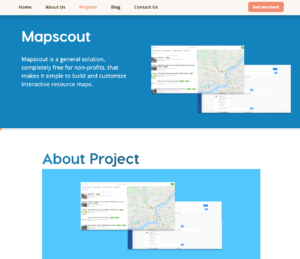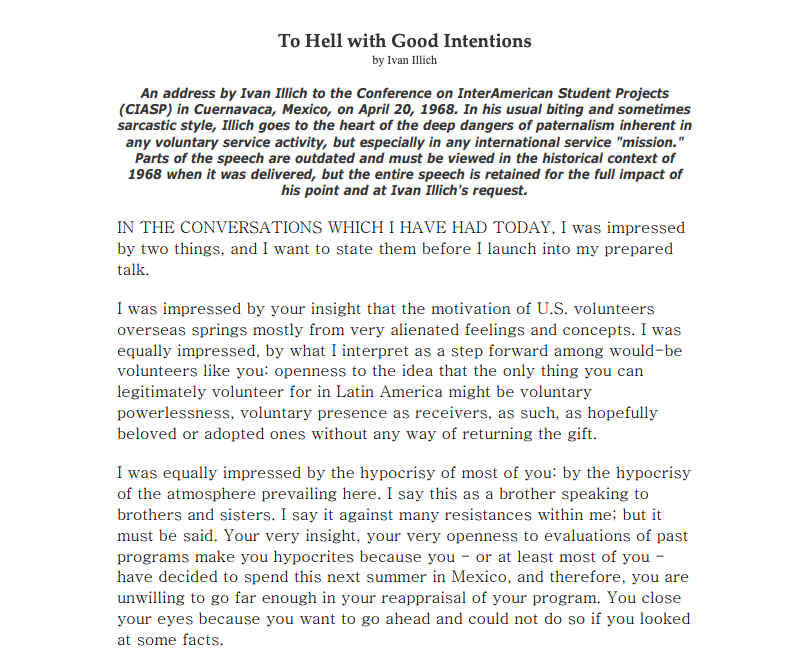Teaching Public Interest Tech
Member Institution
Georgia Institute of Technology
Case Study Lead(s)
Ellen Zegura, Professor of Computer Science
Executive Summary
Georgia Tech Bits of Good/Vertical Integration
The Bits of Good – Vertical Integration Project (BoG-VIP) is a multisemester curricular offering at the Georgia Institute of Technology.
Taught by Ellen Zegura, professor of computer science, the course focuses on software development for nonprofits and is an instance of the Vertically Integrated Projects Program at Georgia Tech. A campuswide initiative, VIP organizes undergraduate and graduate students into teams that work on ambitious, long-term, large-scale, multidisciplinary projects (see vip.gatech.edu).
Students typically enroll in BoG-VIP over multiple semesters, with some participating from early in their time as undergrads through graduation. An important contributor to the course’s success is that students can work on a single project from its inception to its completion over the course of several semesters.
Bits of Good, the Georgia Tech Hack4Impact chapter, is a student-run organization. It selects the collaborating organizations and projects, trains participating students in the relevant technical and other skills, organizes teams, and coordinates between teams and organizations. Professor Zegura focuses on the ethics of building tech for non-profits and invites students to reflect on their experiences throughout the semester.
In the Bits of Good – Vertical Integration Project (BoG-VIP) class, Georgia Tech students obtain experience working with clients; refine their software development skills; learn project management, design, and other skills; and are exposed to the ethical and other challenges of real-world nonprofit development.
They acquire the following specific skills:
- How to serve nonprofit clients ethically and professionally.
- How to collaborate and work in teams.
- How to manage projects (and use project management tools).
- How to manage and supervise other team members (for those who advance to leadership positions).
- How to train themselves and others on the job.
- How to communicate effectively with each other, their client-organization clients, other stakeholders, and members of the public.
Teaching Mission: How can we teach students public interest technology in a more sustainable, meaningful way? How do we get more mentorship, leadership, and student involvement in the class projects?
The VIP-BoG course offering allows students to work under faculty supervision on projects selected, scoped, and overseen through the BoG student organization. Each component — the university VIP initiative and the student-run BoG — combines to make a successful course
VIP at Georgia Tech
Launched in the mid-90s, the Vertical Integration Project Programs at Georgia Tech is an innovative approach to enhancing higher education by engaging undergraduate and graduate students in teams that work on large-scale, multidisciplinary projects under faculty supervision. The program seeks to address three limitations of undergraduate and graduate education: fragmentation caused by the academic calendar, which creates an artificial beginning and end for educational projects; disciplinary fragmentation, which silos faculty and students in particular areas; and the fragmentation, among faculty, of research and teaching interests.
VIP overcomes these barriers, by extending project-based learning beyond a single semester, with students participating for up to three years. Teams of undergraduate students — from various years, disciplines, and backgrounds — work with faculty and graduate students in their areas of scholarship and exploration, earning academic credit on a semester basis. The program provides the time and context for students to gain deeper insights into their fields of study, learn and practice professional skills, make substantial contributions to real-world projects, and experience different roles on large, multidisciplinary teams. The long-term nature of VIP creates an environment of mentorship, with faculty and graduate students mentoring teams, experienced students mentoring new members, and students moving into leadership roles as others graduate. Because faculty members choose projects around their interests, they bring both expertise and enthusiasm to each project.
Professor Zegura’s instance of the VIP differs from others, which are generally organized around faculty research interests. The Bits of Good VIP course capitalizes on students’ commitment to doing work for nonprofits by allowing them to receive credit for their work. In the process, they are exposed to the special ethical challenges of serving organizations with limited resources. Students can take the class for up to three years, with credits counting as free electives or technical electives depending on their major (for example, Computational Media, Computer Science, Industrial Design, and Industrial Engineering).
Bits of Good at Georgia Tech
Professor Zegura’s instance of VIP is integrated with BoG, a student organization dedicated to building technology tools for nonprofits in the Atlanta area. BoG develops projects with local non-profits to provide opportunities for students who want to use their technical background to do good. BoG taps into students’ motivation to engage in work that has a meaningful impact and provides them with institutional structure, training, and mentoring.
Students in the course are required to be part of BoG, which selects its membership based on software coding knowledge, other abilities and skills, and a demonstrated commitment to social good. Many students apply to BoG. The organization is very selective to ensure that members have the appropriate technical competencies, the seriousness of purpose, professionalism, and aptitude for teamwork.
Through a series of boot camps in development and design offered during the year, Bits of Good provides technical, design, and other training so that students have the necessary skills to work on their projects. Team project leaders meet regularly to discuss project management and review team members’ work. Members of the organization also write instructional blogposts. This training relieves Professor Zegura from having to teach all the technical and design skills needed for each project.
Professor Zegura first offered the course in spring 2020 when students in BoG approached her about integrating the organization’s work into the VIP program. At the time, the course had an enrollment of 20, which has since doubled. Most of the students in the class are computer scientists, but it also draws from other departments at Georgia Tech. A key component of the course’s success is that it allows students to see longer and more complex projects to completion all the while developing their technical and product management skills and taking on greater responsibility for the project. The course also relies on BoG’s organizational strengths and the energy and commitment of its membership.
Every student in the VIP class works for BoG but not every member of BoG is in the VIP class, with many members of BoG working as volunteers. Students in Professor Zegura’s VIP class fit seamlessly into the structure delineated above and can have different roles in the project as it progresses over time. These roles can range from serving as a lower-level designer or engineer, to managing the product once the student has gained the necessary training and competence. The course was organized around the specific projects on which students worked.
In its first iteration, the class met as a whole regularly. Now, Professor Zegura meets with teams regularly over the course of the semester. She meets with each team: once in the beginning of the semesters; once for one-on-ones with particular students; once for observing one-on-ones, where one team gives a presentation of the project that addresses a series of pre-assigned questions while another team observes; once for a demo of the team’s work toward the end of the semester; and one final time at the semester. At the end of the term, teams present their projects to the whole class during a demo day.
To demonstrate their work during the semester, students who are doing coding for BoG projects track code commits to GitHub, and all students write an end-of-semester paper reflecting on the entirety of their semester’s work. In future iterations, Professor Zegura intends to invite guest speakers to the class, as many students have expressed interest in hearing from experts from both industry and non-profits.
At the outset of each semester, Professor Zegura assigns Ivan Illich’s classic speech “To Hell with Good Intentions,” a brilliant and scathing critique of “do-goodism,” to encourage ethical reflection. Zegura uses the essay as a vehicle to prompt students to focus on learning about and appreciating the work that their organizational clients do, understanding the value of their projects to clients and the limitations of their own contributions, maintaining concern for the partnerships they create, and reflecting on the sustainability and scaling challenges that arise in non-profit work.
Click here to read the full address
Professor Zegura continues to raise these issues in her meetings with students during the semester. She asks students to consider such questions as:
- Are students operating with a preconceived idea of how technology can address organizational needs?
- What needs has the organization identified?
- What resources does an organization have available to maintain the tool after the project is over?
- Is this tool scalable for easy and low-cost adaptation and use by another organization?
Choosing Projects
Professor Zegura delegates the selection of projects to BoG, which solicits applications from local non-profits. BoG screens proposals to ensure that applicants are designated as 501(c)(3) organizations. BoG also evaluates each proposed project to ensure that there is a fit with members’ skill set, that it aligns with BoG’s values, and that it will have a meaningful impact on the organization’s work.
Projects, which typically involve building a website for a nonprofit organization, can take one or several semesters to complete. Students in the VIP course are fully integrated into BoG; most project teams will be composed of a mix of VIP students and other members of BoG who are not enrolled in VIP.
Key Project Selection Questions
- Feasibility of project.
- Fit with student skills and BoG capacity.
- Scope.
- Impact.
Development Process
Collaborating with Clients to Develop the Product
The students work closely with their nonprofits clients to define the scope and scale of the product. Students will periodically meet with the nonprofits during== the semester to seek their input on the design process and run any finished features of the product by them. This iterative process enables the student team to make sure that what it is creating suited the needs of the nonprofit. Along the way, the students begin to develop an understanding of their clients’ service mission and needs. This process also serves as a way for the staff of the non-profit to gain a better understanding of the technology that will underpin the finished product. Students gain insight into the limits of lay people’s understanding of what technologies can and can’t do.
Key Collaborative Elements
- Regular meetings.
- Feedback-focused iterative design process.
- Clear delineation of technological limitations.
Delivering on the Project
Students are given discrete tasks to complete on a weekly basis and receive input from their managers each week. If students have questions, they take them to their managers. Students start work directly on the project so they in essence learn on the job. This experiential learning, combined with the development and design boot camps offered by BoG, provides them with a solid foundation for wherever their career might take them.
During the development boot camp students spend a semester following along with the BoG online curriculum completing activities as they go; attending virtual workshops twice a week; and attending office hours to catch up on missed material.
Students in the design boot camp participate in a 10-week course on the core fundamentals of UX/UI and designing for digital products where they learn about: user research methods and frameworks; how to create user flows and information architecture; and designing and prototyping in Figma, a collaborative interface design tool. At the end of the semester, many students come away impressed with how much they were able to do in such a short time frame.
Institutional and Teaching Challenges
Necessary Institutional Infrastructure
For a course like this to succeed, students have to be able to receive credit for the work that they do, ideally with the possibility of getting multiple semesters, worth of credit for multiple semesters of work. There must also be a strong student-led organization, like BoG, that has the necessary components to provide technical training and mentoring to students who have varying levels of coding background and can staff and oversee projects.
Grading
Assigning grades to students is difficult since they start with different levels of competency in computer programming and have different roles in a project. Some of the students with extensive prior experience may be slotted directly into a product management position, while others may have no previous coding or other relevant experience.
Project-based Challenges
Organizational Commitment
Sometimes organizations have limited capacity and may not be able to sustain interest in the project. Students note that since they are providing this work for free, some organizations could have the tendency to “set and forget,” meaning that they provide some information upfront and as the semester goes along realize that the commitment required of them is greater than they had anticipated.
BoG manages to get around this problem at the front end by having a rigorous nonprofit selection process, part of which was detailed above.
Sustainability
Over time the website needs to be maintained and if the organization is not committed from the beginning to understanding the process they might have difficulty updating the information on the site. BoG tries to make it as easy as possible for the nonprofits to swap out different pieces of content and provides explanations on how to do it, but again the retention of the knowledge of how to successfully do that is dependent on the non-profit’s commitment and technical acumen.
Scalability
Along with sustainability, scalability can prove to be a challenge. Many of these projects are created for a specific client organization based in Atlanta. Many of these Atlanta organizations are subchapters of larger national organizations that could benefit from using the technology. If each subchapter of the national organization contacted BoG and wanted slightly different customized tools, BoG would have no way to easily provide that. BoG is necessarily limited by the number of students in the organization and the amount of time the students can commit to a project (even if it is for credit).
- Have an organizational structure that fosters experiential learning on a particular project that extends over the course of one semester.
- Have a rigorous application process to weed out nonprofits that will not be committed.
- Have an iterative design process that involves the nonprofit from the get-go to make sure that the scale and impact of the project are appropriate.
- Understand that business, like life, can be unpredictable and that if circumstances are such that a project cannot be completed due to complicating factors on the part of the organization, it is is not a reflection of student work or commitment.
One example of an innovative project is the Health and Development Guatemala project, which was done in collaboration with Emory Helps Guatemala (EHG). The goal of this project is to expand access to health care information in rural Guatemala through the use of a WhatsApp chatbot.
In many places in rural Guatemala, people do not have access to local health services so they live in a health care information desert. The WhatsApp chatbot dispenses health care information so that anyone whose cell phone has access with regular network coverage can access it.
By partnering with EHG, BoG has access to medical students who provide them with the language that the chatbot uses to explain health information. Once live, people will be able to text a regular cellphone number and will answer and ask questions to receive information about pertinent medical conditions and symptoms.
Originally, BoG and EHG activists would travel down to Guatemala to speak with people on the ground but due to the COVID-19 pandemic, the meetings have been virtual. Through EHG, BoG was able to gain the use of interpreters so that participants could solicit user feedback on the design elements of their app and make the necessary changes. This iterative process is highly beneficial because it enables BoG to tailor the product to the needs of the people who will use it.
This project is a nontraditional BoG project because there is no physical website attached to it. The product that BoG has provided EHG with is dynamic, with medical students at Emory being able to change the content of the chatbot themselves through an admin portal when they receive user feedback or want to add additional information.
An example of a multisemester project is the MapScout project that was recently concluded.
This project was initially intended to be for internal BoG use to more efficiently serve nonprofit clients by allowing students teams to create resource maps for their clients more easily (think Yelp and Airbnb).

Since its inception, MapScout has transformed into being a project that allows the non-profits themselves to efficiently create customizable and intuitive maps to represent their location data. MapScout’s template builder gives non-profits complete control over the information and search filters presented on their unique maps.
Non-profit organizations can sign up to use the tool at MapScout.io (currently the demand from nonprofits is so high that there is a waiting list). This shows that by focusing on an internal efficiency project for a couple of semesters and allowing it to evolve, BoG created a tool that will scale to help dozens, if not hundreds, of nonprofits.

